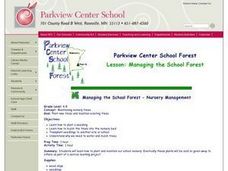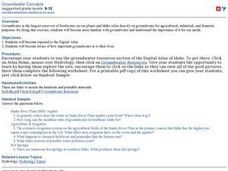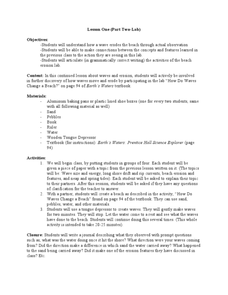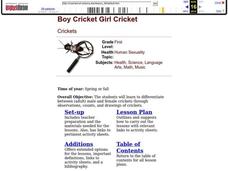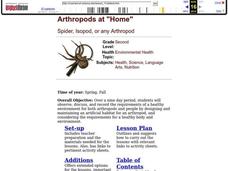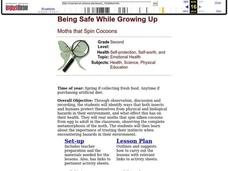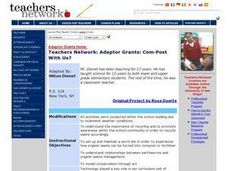Curated OER
Introduction To Data Analysis
Seventh graders investigate the concept of looking at the data put in a variety of ways that could include graphs or data sets. They analyze data critically in order to formulate some sound conclusions based on real data. Students graph...
Curated OER
Exploring the Sun's Role in Living Systems
Learners create graphic organizer webs that illustrate their thinking about seasonal physical and biological changes caused by changes in sunlight. They identify the central role of sunlight in living systems.
Curated OER
MANAGING THE SCHOOL FOREST
Students study how to plant a seedling, how to mulch the trees into the nursery bed, transplant seedlings to another site or school, and determine why we need to water and mulch trees.
Curated OER
Rainsticks
Students create a rainstick decorated with repeated patterns of shape and color, out of paper towel tubes.
Curated OER
And Now for Something Completely Different...
Young scholars identify organisms that are typical a part of a hydrothermal vent. They examine why hydrothermal vents are short-lived.
Curated OER
Where Did They Come From?
Students explain hydrothermal vents and the process in which species and the hydrothermal vents become isolated.
Curated OER
Technology and Geography
Ninth graders, working in pairs, use a multimedia world atlas, Encarta Multimedia Encyclopedia and the Internet (as well as any text materials found in the library) to research information about a specific region of the world.
Curated OER
Groundwater Concepts
Students use a digital atlas and other electronic resources to explore freshwater reservoirs in Idaho. They discover the importance of groundwater and discuss the agricultural, industrial and domestic uses of underground reservoirs....
Curated OER
The Cycle of Restoration
Pupils describe what is meant by restoration cycle. In groups, they create a poster to show the cycle of restoration work. After presenting their poster, they discuss the actions that can be done for each season. To end the lesson, they...
Curated OER
Tree Identification
In this tree identification worksheet, students collect samples from different trees and identify them using the deciduous tree guide or the conifer key.
Curated OER
QUILT SHARING
Students share in the family histories of their peers as told through the quilt stories, and apply math skills by using invented strategies to determine the (approximate) age of the quilt from the information given about the date it was...
Curated OER
You Belong in the Zoo Project - Using HyperStudio
Learners explore the diversity of living organisms. They research an animal found in the zoo and plans a 10-card HyperStudio project about his/her organism.
Curated OER
Where is Water Found?
Fourth graders examine the amount of water and its distribution on Earth. As a class, they brainstorm a list of where water can be found and classify the places according to salt water, fresh water or glaciers. They estimate how much...
Curated OER
How Do Waves Change a Beach?
Students conduct an experiment on beach erosion. In this earth science lesson, students create a beach model and use tongue depressor to produce waves. They write a journal about their observations.
Curated OER
Head, Shoulders, Knees & Toes
Students, through observation of crickets, recognize and use proper names for human and insect body parts. They compare and contrast parts of human and insect body parts.
Curated OER
Think Safe! Be Safe!
Students predict, observe, and explain how pillbugs, grasshoppers, stink bugs, and humans stay safe and protect themselves.
Curated OER
Boy Cricket Girl Cricket
First graders differentiate between (adult) male and female crickets through observations, counts, and drawings of crickets.
Curated OER
Arthropods at
Young scholars observe, discuss, and record the requirements of a healthy environment for both arthropods and people by designing and maintaining an artificial habitat for an arthropod.
Curated OER
Being Safe While Growing Up
Second graders identify ways that both insects and humans protect themselves from physical and biological hazards in their environment. They rear moths from egg to adult and consider the importance of trusting their own instincts.
Curated OER
Latin America and the Caribbean in the Classroom: The Economy and Trade
Learners use the internet to gather information on daily exchange rates. They calculate the exchange rates between two countries by role playing they are going on vacation to these destinations.
Curated OER
A Moment When My Life Changed
Students recognize symbols in a work of art, analyze composition of picture by Hollis Sigler, and plan and execute compositions that successfully tell stories, primarily with symbols.
Curated OER
Pawing Around
Students identify common wildlife by investigating their footprints. They examine where and how to look for signs of animal activity. They create casts of animal tracks and gather information about the animal from the location it was found.
Curated OER
Arbor Day Across the United States
Students perform research about hardiness zones used to guide planting. They read a hardiness zone color-key map and create their own color-key maps to show when different states celebrate Arbor Day.
Curated OER
Com-Post With Us?
Students discuss the importance of reducing, recycling and reusing materials to help the environment. As a class, they create a worm bin and observe how it turns material in to compost. They use the internet to research the...




